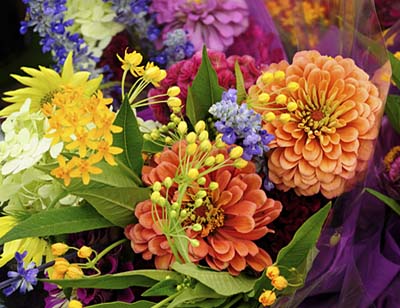How to have cut flowers all year round
Country Life visits a thriving cut-flower nursery in Kent to find out how to grow flowers all year round


In due season, when the late flowers are in full sail, the Blooming Green cutting garden shimmers in uncust-omary heat, and the High Weald of Kent is a smudge on the horizon across the valley. Low sun glances off serried rows of fiery photinia tips, rosy-pink symphoricarpos snowberries and the black-red leaves of Amaranthus Oeschberg. A solitary visitor, pail in hand, drifts between the rows, snipping off a spray of Verbena bonariensis here and a stem of lemon-scented Agastache mexicana there.
The cutting garden, now in its fourth year, is run by first cousins Jen Stuart-Smith and Bek Bibby, daughters of Kent farmers. When she was 12, Jen's father bet her £5 she couldn't win a flower-arranging competition. She rose to the challenge and, emerging triumphant, her passion was ignited. She has been arranging flowers for weddings, funerals and other events ever since, in between journalistic assignments. Her long-held intention to return to her roots in Kent was given impetus by Sarah Raven's books and by the interest she saw in local, seasonal cut flowers. She approached her cousin, and enlisted her as grower. ‘There's a tipping point, and I knew if we didn't do it then, we would miss the boat.'
In the winter of 2007/2008, they started work on a worn-out Bramley orchard on the family farm. The trees were grubbed up, and the compacted soil deep-ploughed, power-harrowed and enriched to prepare it for organic gardening. Raised beds were covered with a woven polypropolene weed-suppressant fabric, which allows through rain but not light. Only half an acre was used productively in the first year, the rest being covered with cow muck and grass seed as a green manure. Mrs Bibby also annually lays down 6mm-8mm of finely graded compost, which is shredded and turned garden waste, available from most councils.

The hilltop site is exposed, so the cousins have planted native birch, rowan and willow to protect it from blasting south-westerly winds. ‘The original gappy windbreak had been planted between the lines of apple trees, so it looked like a row of broken teeth,' explains Miss Stuart-Smith. ‘You need as sheltered a corner as possible for cutting flowers-a walled garden is best.'
Choosing what to grow was a challenge. ‘I had a wish list of about 500 plants,' says Mrs Bibby. ‘We wanted native species for wildlife: a garden full of wonderful plants for bees and flies is a double whammy.' Every flower arrangement should have a mixture of different sized and shaped flowers, they advise.
‘You need spectacular annuals such as sunflowers and zinnias with perennial fillers-umbellifers such as achilleas, and sedums, solidago and Michael-mas daisies. I'll put zingy zinnias with lime-green bupleurum or pale Achillea Moon-walker,' adds Miss Stuart-Smith. ‘Foliage is important-cotinus with juvenile leaves, which flow in a circle round the stem, and green pittosporum, which does well here, but might struggle in a frost pocket.'
Family and gardening friends were generous with advice and with plants and cuttings. There have even been quixotic gestures. ‘A "guerrilla gardener" came one day while I was out,' comments Miss Stuart-Smith, ‘and planted a whole row of delphiniums, which would otherwise have been thrown away.'
Sign up for the Country Life Newsletter
Exquisite houses, the beauty of Nature, and how to get the most from your life, straight to your inbox.
The garden needs year-round planning and care: hyacinths, alliums, anemones and tulips are planted in the autumn, hardy annuals sown, and sweet peas started off in the greenhouse. April and May are the busiest months, with more sowing, potting on and planting out. From then until October, wedding flowers are key. Managing bridal expectations can be testing. ‘There's a certain amount of stress,' admits Miss Stuart-Smith. ‘You have to be very good at improvising and hope that most brides come to us because we provide beautiful country flowers. This has been the first year that we haven't had to buy anything in.'
In four years, Blooming Green has developed and diversified, but has remained a cottage industry. Bouquets are sold online, and delivered wrapped in home-compostable plastic, organic ribbon and 80% recycled card containers. The cousins also run seasonal flower-arranging courses and hold pick-your-own summer open days. ‘We're quite relaxed about it now,' says Mrs Bibby. ‘The reason for doing this business is people as well as flowers.'
Miss Stuart-Smith continues to work two days a week as a journalist in London, where she also arranges the editor's flowers and sells bouquets to her colleagues. There is a charming seamlessness about the two very different strands of her life.
Blooming Green, Loddington Farm, Linton, near Maidstone, Kent (01622 745917; www.bloominggreenflowers.co.uk). Groups and individuals welcome to visit by appointment. Visit the website for details of their courses.
How does your garden grow?
Keeping a cutting garden
- Use a tucked-away corner. A cutting garden is a production area, and if you think of it as a show garden, you'll be reluctant to cut
- You need a mixture of annuals and perennials
- Look out for catalogues that suggest
specific plants and flowers for cutting
- Seed is the cheapest way of growing annuals such as zinnias, cornflowers and cosmos
- Don't grow all of one species together to avoid wipe-out from a species-specific disease
Picking flowers
- Pick straight into water, early in the morning or in the evening
- Strip off leaves and side shoots so you're left only with what you need for your arrangement
- Leave flowers in water in a cool, dark place for at least four hours before arranging
- Put a dash of fizzy, non-diet lemonade in the water. The bubbles dissolve into carbonic acid to kill off bacteria, and the sugar feeds the flowers
Recommended flowers and foliage
Perennials Purple Verbena bonariensis Various achilleas in pinks, reds, and apricot (A. Moonwalker and The Pearl are lovely) Pink and blue veronicas Blue and white delphiniums Feathery, silver Eryngium alpinum Slieve Donard Purple Agastache mexicana, with a citrus scent, and minty-scented purple-coral Agastache rupestris
Biennials
White sweet rocket (Hesperis matronalis) Pinky-red Sweet William (Dianthus barbatus) Honesty (Lunaria) for its seed pods
Annuals
Zinnias in a range of colours Sunflowers (Helianthus annuus) Dill (Anethum graveolens) Bupleurum rotundifolium Griffithii Cornflowers, which look lovely growing, or Catananche caerulea, which is easier to pick and has seedheads for drying Nigella for flowers and seeds
Foliage
Guelder rose (Viburnum opulus) for foliage, lacecap flowers and autumn berries Cotinus, both the purple C. coggygria Royal Purple and the golden-green C.g. Flame Green pittosporum, rather than the less hardy variegated Juvenile foliage of eucalyptus Euphorbia-although be careful of its sap. Euphorbias exude a latex that is caustic Spindleberry (Euonymous europaeaus), also for its berries
- Subscribe to Country Life and save over £50 a year
Country Life is unlike any other magazine: the only glossy weekly on the newsstand and the only magazine that has been guest-edited by HRH The King not once, but twice. It is a celebration of modern rural life and all its diverse joys and pleasures — that was first published in Queen Victoria's Diamond Jubilee year. Our eclectic mixture of witty and informative content — from the most up-to-date property news and commentary and a coveted glimpse inside some of the UK's best houses and gardens, to gardening, the arts and interior design, written by experts in their field — still cannot be found in print or online, anywhere else.

